History | 16.11.2009
The start of World War II – September 1, 1939
Since the fire in the Reichstag at the end of February 1933, the parliamentarians had been meeting at the Kroll Opera House in Berlin. Six years after the NSDAP and its leader, Adolf Hitler, seized power in an intrigue known as the "Machergreifung," all they really did was nod their assent to the laws the government wanted. They weren't really a part of the decision-making process anymore. All MPs were members of NSDAP (National Socialist German Workers' Party); other parties were forbidden and their leaders either killed, arrested, exiled or silenced in some other way. On September 1, 1939, there was a tense calm before the session began.
The Gleiwitz incident
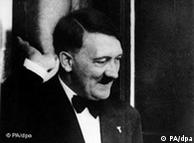 Bildunterschrift: Großansicht des Bildes mit der Bildunterschrift: Adolf Hitler
Bildunterschrift: Großansicht des Bildes mit der Bildunterschrift: Adolf Hitler
Hitler took to the podium at around 10 am, and said that the Polish army had sent "regular soldiers" into German territory and opened fire. "Since 5:45 am" Germany had been returning fire and "meeting bombs with bombs." He'd barely uttered the words when the parliamentarians began jumping from their chairs and shouting "Heil Hitler!"
Later, a supposed attack in which Polish saboteurs seized the German radio station Sender Gleiwitz near the Polish border was cited as the cause for war. During the incident, anti-German messages were broadcast and a technician killed. But the "attack" was staged, and likely unfolded at the command of the head of the Security Office, Reinhard Heydrich (1904 – 1942).
While the enthusiasm among the parliamentarians was great, the population was comparatively quiet. For many, the memories of World War I were still too fresh for them to react with excitement to the news that Germany had invaded Poland.
Blitzkrieg
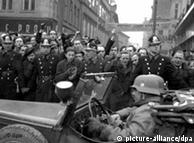 Bildunterschrift: Großansicht des Bildes mit der Bildunterschrift: The German army in Prague
Bildunterschrift: Großansicht des Bildes mit der Bildunterschrift: The German army in Prague
In the early stages of the war, their worries were unfounded, as the German armed forces took Poland in just a little over six weeks. In 1940, the occupation of Denmark and Norway followed. On May 10, 1940, German troops invaded first the neutral states of Belgium, the Netherlands and Luxembourg, and eventually France. On June 21, 1940, French negotiators signed a ceasefire agreement. After exactly six weeks and three days, the Blitzkrieg in the West was over, and Hitler, the "greatest commander of all time" was at the height of his popularity.
While the attempt to conquer England from the air failed in 1941, in the same year, German troops took the whole of the Balkans and, with their Italian allies, gained a foothold in northern Africa.
Invasion of the Soviet Union
The Germans and their allies seemed impossible to beat. The same held true in the initial phases of the war against the Soviet Union. On June 22, 1941, "Operation Barbarossa" began. The German troops steadily advanced until the summer of 1942. But the air raid carried out by German ally Japan on the American military base in Pearl Harbor on December 7, 1941 changed the military situation completely. As a consequence of Pearl Harbor, the US joined the war against Germany. Within a few months, the entire American economy was focused on the production of goods for the war effort.
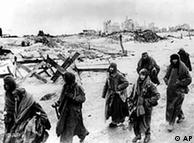 Bildunterschrift: Großansicht des Bildes mit der Bildunterschrift: The Battle of Stalingrad, 1943
Bildunterschrift: Großansicht des Bildes mit der Bildunterschrift: The Battle of Stalingrad, 1943
In addition to this added boost to the Allied campaign against Germany, the Germans began suffering their first military defeats. At the end of January 1943, the Battle of Stalingrad ended in total defeat for the German army under General Friedrich Paulus (1890 – 1957). This defeat marked a turnaround in the second World War, with Soviet troops from the east and the Allied troops closing in on Germany. By mid-April 1945, they had advanced from all sides to the city limits of Berlin, and began burying the German capital in soot and ashes. The Germans capitulated on May 9, 1945.
Consequences of war
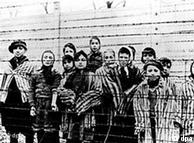 Bildunterschrift: Großansicht des Bildes mit der Bildunterschrift: Children in Auschwitz
Bildunterschrift: Großansicht des Bildes mit der Bildunterschrift: Children in Auschwitz
Some 100 million people suffered as a result of World War II. Some 50 million died on the battlefields stretching from Africa to the northern tip of Norway, or in the Nazi death camps as victims of racial persecution. A further 50 million survived the war only to become orphans, homeless, disabled or expellees. The people of Europe were traumatized by six years of fighting, and their cities and villages lay in ruin. Nobody knew how they were going to survive tomorrow.
Shortly after the fighting ended, the European continent was divided. In the East, the Soviet Union ruled, while the West was ruled by the US. The "demarcation line" ran through Germany and Berlin. The "Cold War" that quickly developed between the socialist countries in the eastern bloc and the “"ree democratic states" in the West had its front along the border separating the German Democratic Republic (East Germany) and the Federal Republic of Germany (West Germany). At the end of August 1961, this separation seemed to be cemented forever by the erection of the Berlin Wall and a barbed wire fence through the whole of Germany.
Author: Matthias von Hellfeld (dc)
Editor: Andreas Illmer
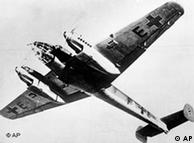
Comments